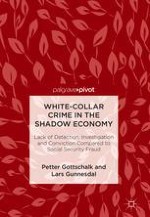Open Access 2018 | Open Access | Buch

White-Collar Crime in the Shadow Economy
Lack of Detection, Investigation and Conviction Compared to Social Security Fraud
verfasst von: Prof. Petter Gottschalk, Lars Gunnesdal
Open Access 2018 | Open Access | Buch

verfasst von: Prof. Petter Gottschalk, Lars Gunnesdal
This open access book examines the magnitude, causes of, and reactions to white-collar crime, based on the theories and research of those who have uncovered various forms of white-collar crime. It argues that the offenders who are convicted represent only ‘the tip of the iceberg’ of a much greater problem: because white-collar crime is forced to compete with other kinds of financial crime like social security fraud for police resources and so receives less attention and fewer investigations. Gottschalk and Gunnesdal also offer insights into estimation techniques for the shadow economy, in an attempt to comprehend the size of the problem. Holding broad appeal for academics, practitioners in public administration, and government agencies, this innovative study serves as a timely starting point for examining the lack of investigation, detection, and conviction of powerful white-collar criminals.